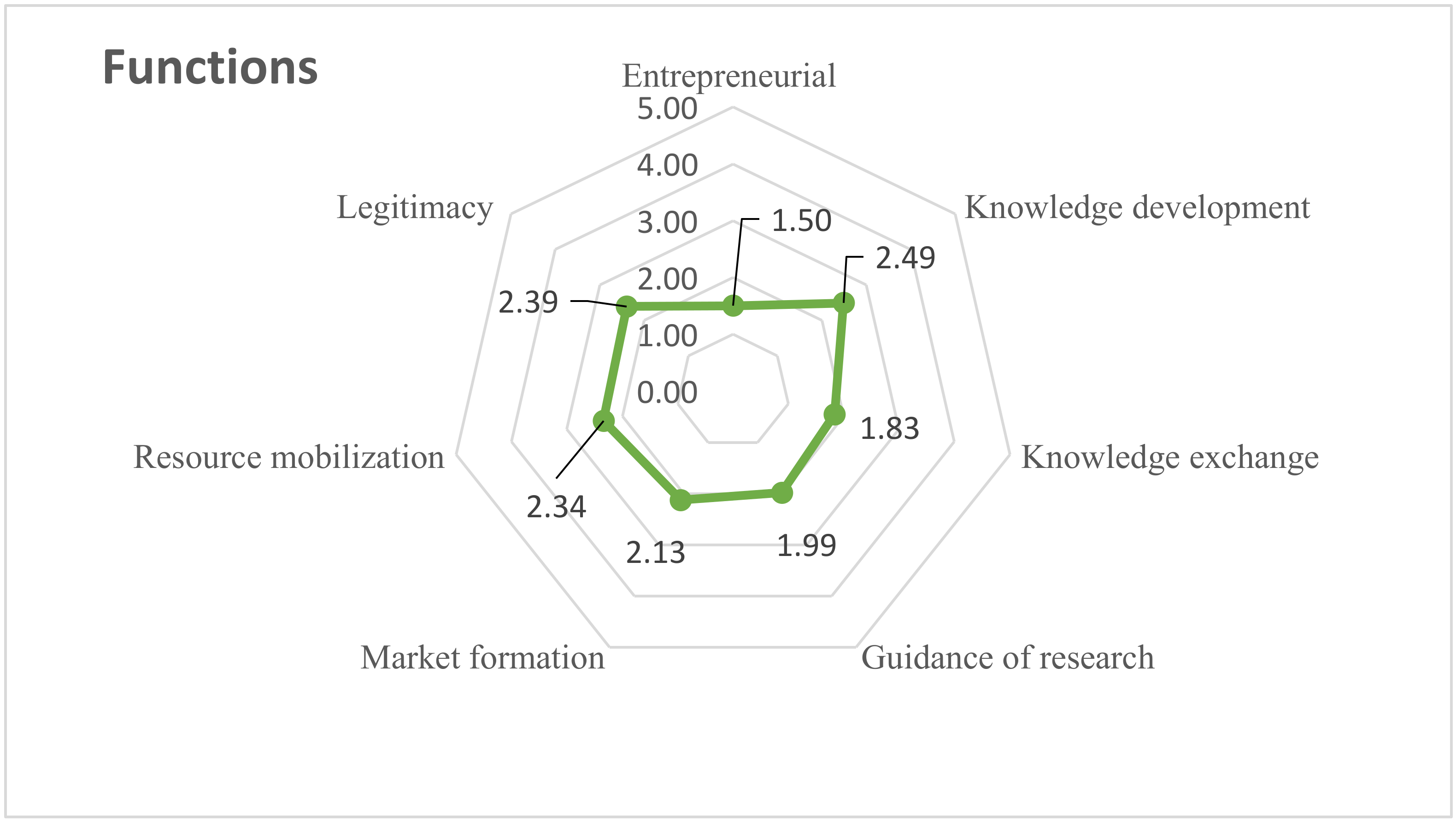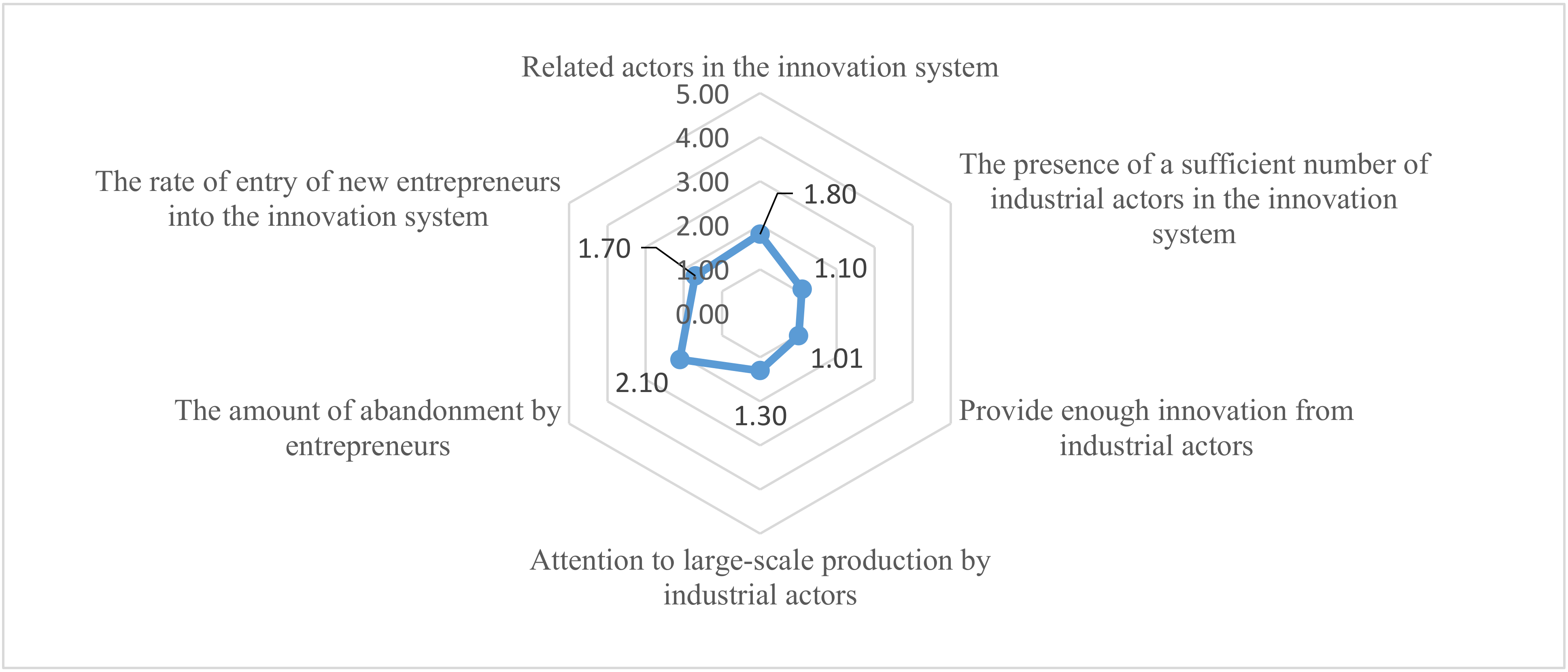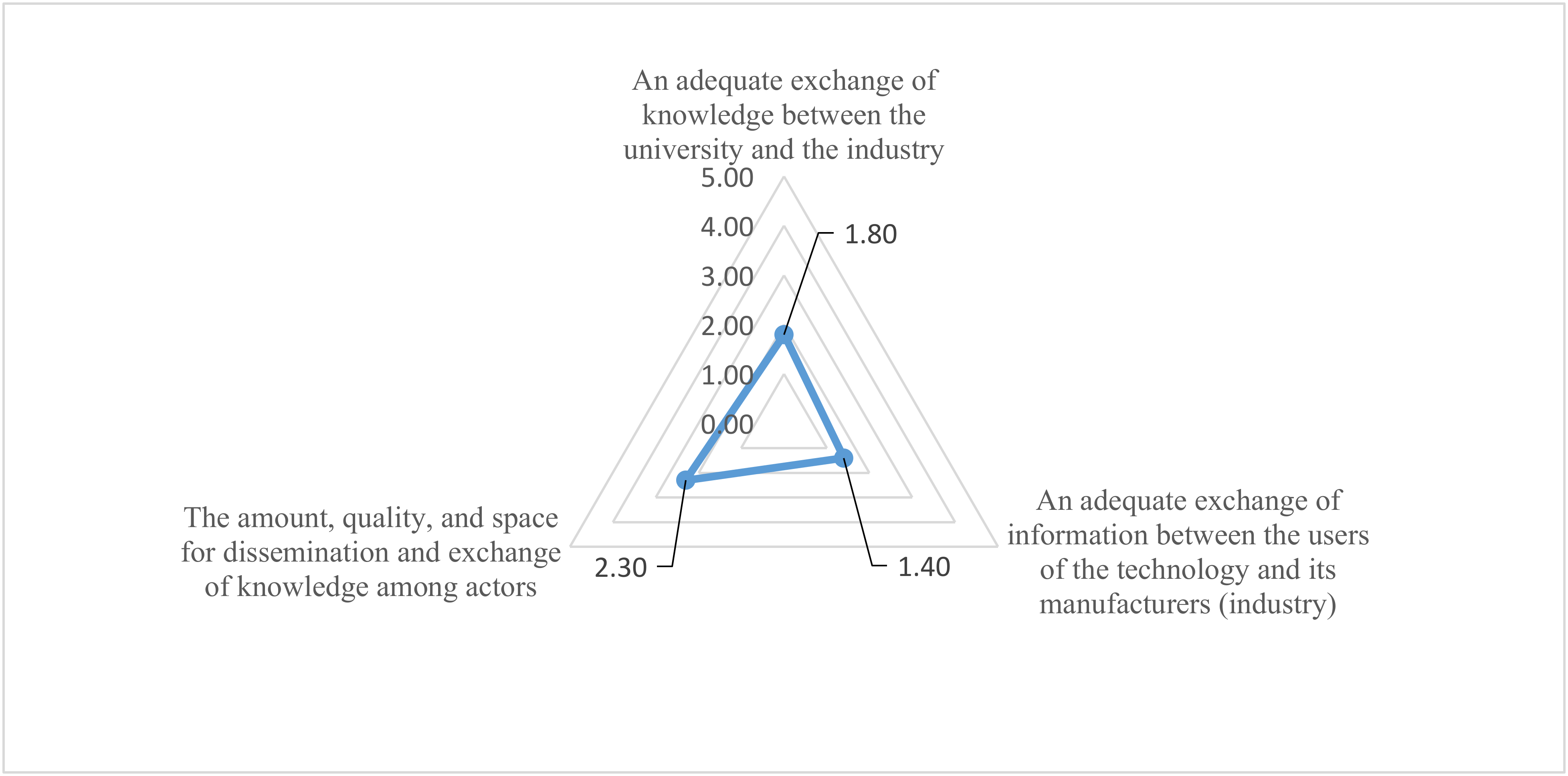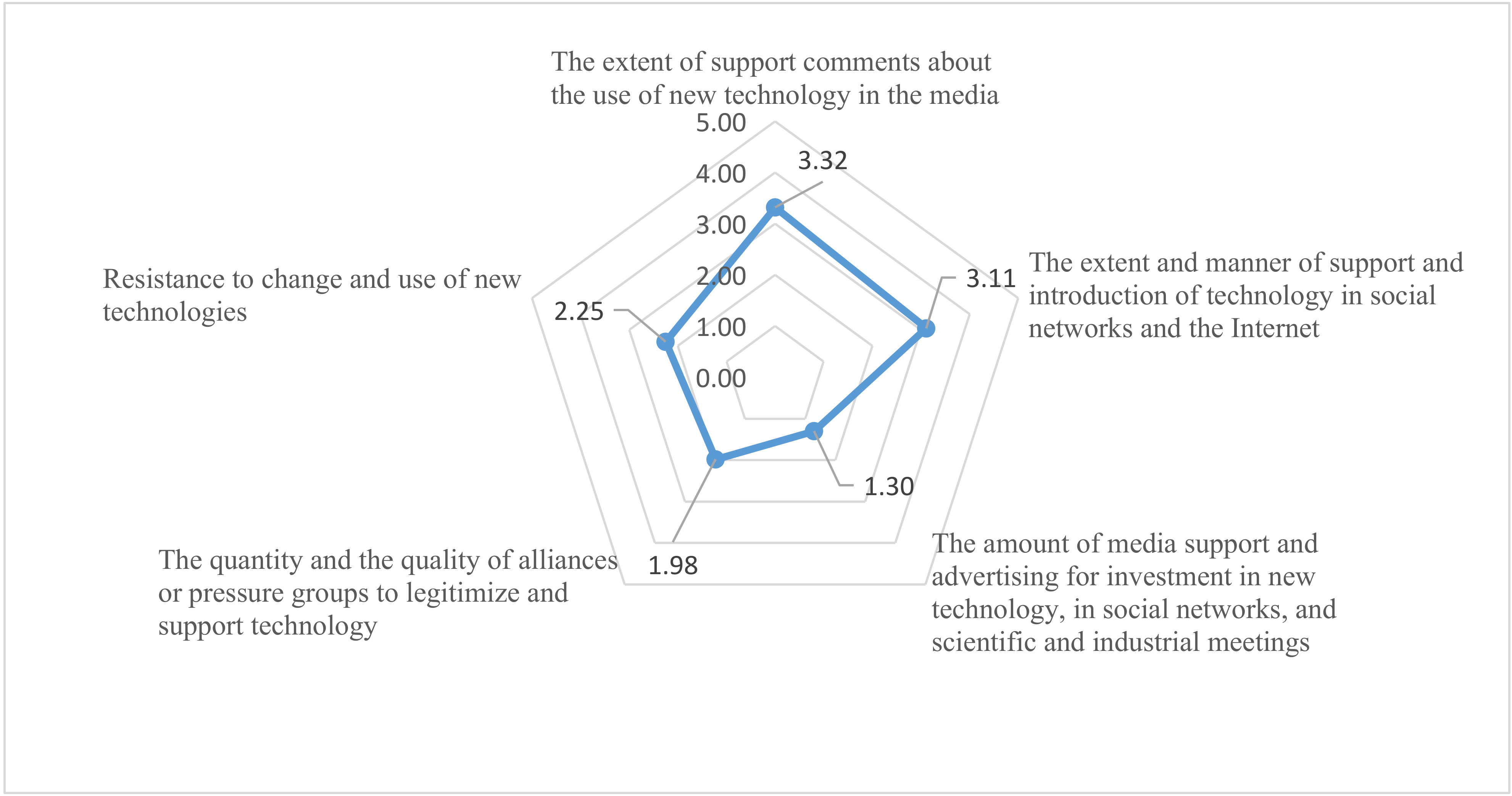A Functional Analysis of Technological Innovation Systems in Developing Countries: An Evaluation of Iran’s Photovoltaic Innovation System
Abstract
1. Introduction
2. Literature Review
2.1. Innovation System and TIS Framework
2.2. Innovation Policy
2.3. Functions of Innovation Systemss
- Entrepreneurial activities: The activities of the innovation system which relate to business startups, diversification, and testing of new technologies.
- Knowledge development (learning): Educational activities on the technical, social, and economic aspects of new technologies.
- Knowledge exchange (through networks): Those activities and processes of innovation that focus on information dissemination, awareness raising, and capacity-sharing and resource sharing among system actors.
- Guidance of the research: This function is about creating hope and optimism about the future of new technologies. The aim of this function is also reducing the uncertainty and risks associated with new technologies.
- Market Formation: It covers functions, activities, and processes that can create tools for new technologies. This function will extend the market for new technologies by providing market protection standards.
- Resource mobilization: Human and financial resources are economic variables for the emergence and success of an innovation. This function distributes the necessary resources for the development and diffusion of new technologies among actors of the innovation system.
- Legitimization (neutralize resistance to change): New technologies often fail to gain approval from key actors and policymakers. This function carries out activities that provide legitimacy for new technologies [8].
3. Suggestions to Evaluate TIS Functions in Developing Countries
3.1. Knowledge Development
3.1.1. Absorptive Capacity
3.1.2. Technological Learning
3.2. Resource Mobilization:
3.3. Market Formation
4. Methodology
- Researchers who have been working at least for five years at research centers where their main task is to develop green energies.
- Professors who have been working in the field of clean energy at least for five years.
- Managers of startups, companies, or power plants that have been working in the field of PV and other clean energies at least for two years.
- Managers who have been working in governmental bodies in which their main role is to develop green and clean energies, such as wind and solar.
5. Results
5.1. Entrepreneurial Activities
5.2. Knowledge Development
5.3. Knowledge Exchange
5.4. Guidance of Research
5.5. Market Formation
5.6. Resource Mobilization
5.7. Legitimization
6. Discussion and Policy Recommendations
7. Conclusions
Author Contributions
Funding
Conflicts of Interest
References
- Palm, A.A. An Emerging Innovation System for Deployment of Building-Sited Solar Photovoltaics in Sweden. Environ. Innov. Soc. Transitions 2015, 15, 140–157. [Google Scholar] [CrossRef]
- Haegel, N.; Margolis, R.; Buonassisi, T.; Feldman, D.; Froitzheim, A.; Garabedian, R.; Green, M.; Glunz, S.; Henning, H.-M.; Holder, B.; et al. Terawatt-Scale Photovoltaics: Trajectories and Challenges. Science 2017, 356, 141–143. [Google Scholar] [CrossRef] [PubMed]
- Negro, S.O.; Hekkert, M.P.; Smits, R.E. Explaining the Failure of the Dutch Innovation System for Biomass Digestion—A Functional Analysis. Energy Policy 2007, 35, 925–938. [Google Scholar] [CrossRef]
- Bergek, A.; Jacobsson, S.; Carlsson, B.; Lindmark, S.; Rickne, A. Analyzing the Functional Dynamics of Technological Innovation Systems: A Scheme of Analysis. Res. Policy 2008, 37, 407–429. [Google Scholar] [CrossRef]
- Hekkert, M.; Negro, S.; Heimeriks, G.; Harmsen, R. Technological Innovation System Analysis a Manual for Analysts; Utrecht University Faculty of Geosciences; Copernicus Institute for Sustainable Development and Innovation: Utrecht, The Netherlands, 2011; pp. 1–15. [Google Scholar]
- Jacobsson, S.; Johnson, A. The Diffusion of Renewable Energy Technology: An Analytical Framework and Key Issues for Research. Energy Policy 2000, 28, 625–640. [Google Scholar] [CrossRef]
- Markard, J.; Hekkert, M.; Jacobsson, S. The Technological Innovation Systems Framework: Response to Six Criticisms. Environ. Innov. Soc. Transitions 2015, 16, 76–86. [Google Scholar] [CrossRef]
- Hekkert, M.P.; Suurs, R.A.A.; Negro, S.O.; Kuhlmann, S.; Smits, R.E.H.M. Functions of Innovation Systems: A New Approach for Analysing Technological Change. Technol. Forecast. Soc. Change 2007, 74, 413–432. [Google Scholar] [CrossRef]
- Hellsmark, H.; Mossberg, J.; Söderholm, P.; Frishammar, J. Innovation System Strengths and Weaknesses in Progressing Sustainable Technology: The Case of Swedish Biorefinery Development. J. Clean. Prod. 2016, 131, 702–715. [Google Scholar] [CrossRef]
- Chung, C.C.; Yang, S.C. The Emergence and Challenging Growth of the Bio-Ethanol Innovation System in Taiwan (1949–2015). Int. J. Environ. Res. Public Health 2016, 13, 230. [Google Scholar] [CrossRef]
- Edsand, H.E. Technological Innovation System and the Wider Context: A Framework for Developing Countries. Technol. Soc. 2019, 58, 38. [Google Scholar] [CrossRef]
- Mingyong, L.; Shuijun, P.; Qun, B. Technology Spillovers, Absorptive Capacity and Economic Growth. China Econ. Rev. 2006, 17, 300–320. [Google Scholar]
- Castellacci, F.; Natera, J.M. The Dynamics of National Innovation Systems: A Panel Cointegration Analysis of the Coevolution between Innovative Capability and Absorptive Capacity. Res. Policy 2013, 42, 579–594. [Google Scholar] [CrossRef]
- Kim, Y.; Lee, B. Patterns of Technological Learning among the Strategic Groups in the Korean Electronic Parts Industry. Res. Policy 2002, 31, 543–567. [Google Scholar] [CrossRef]
- Freeman, C. Technology Policy and Economic Performance; Pinter: London, UK, 1987. [Google Scholar]
- Lundvall, B.-A. National Systems of Innovation: Towards a Theory of Innovation and Interactive Learning; Pinter Publishers: London, UK, 1992. [Google Scholar]
- Nelson, R. National Innovation Systems. A Comparative Analysis; Oxford University Press: Oxford, UK, 1993. [Google Scholar]
- Edquist, C. Systems of Innovation Approaches—Their Emergence and Characteristics. In Systems of Innovation: Technologies, Institutions and Organizations; Pinter/Cassell: London, UK, 1997; pp. 1–35. [Google Scholar] [CrossRef]
- Cooke, P.; Uranga, M.; Etxebarria, G. Regional Innovation Systems: Institutional and Organisational Dimensions. Res. Policy 1997, 26, 475–491. [Google Scholar] [CrossRef]
- Malerba, F. Sectoral Systems of Innovation and Production. Res. Policy 2002, 31, 247–264. [Google Scholar] [CrossRef]
- Carlsson, B.; Stankiewicz, R. On the Nature, Function and Composition of Technological Systems. J. Evol. Econ. 1991, 1, 98–118. [Google Scholar] [CrossRef]
- Leydesdorff, L.; Porto-Gomez, I. Measuring the Expected Synergy in Spanish Regional and National Systems of Innovation. J. Technol. Transf. 2019, 1, 189–209. [Google Scholar] [CrossRef]
- Oinas, P.; Malecki, E.J. Spatial Innovation Systems. In Making Connections, Technological Learning and Regional Economic Change; Malecki, E.J., Oinas, P., Eds.; Aldershot: Ashgate, UK, 1999; pp. 7–33. [Google Scholar]
- Asheim, B.; Gertler, M. The Geography of Innovation. In The Oxford Handbook of Innovation; Fagerberg, J., Mowery, D.C., Nelson, R.R., Eds.; Oxford University Press: Oxford, UK, 2005. [Google Scholar]
- Benjamin, S.; Kaplan, D.; Schroeder, D. National, Regional, and Sectoral Systems of Innovation—An Overview; Report for FP7 Projet, “Progress”; European Commission: Brussels, Belgium, 2013. [Google Scholar]
- Malerba, F. Sectoral Systems of Innovation: A Framework for Linking Innovation to the Knowledge Base, Structure and Dynamics of Sectors. Econ. Innov. New Technol. 2005, 14, 63–82. [Google Scholar] [CrossRef]
- Chaminade, C.; Intarakumnerd, P.; Sapprasert, K. Measuring Systemic Problems in National Innovation Systems. An Application to Thailand. Res. Policy 2012, 41, 1476–1488. [Google Scholar] [CrossRef]
- Carlsson, B.; Jacobsson, S.; Holmén, M.; Rickne, A. Innovation Systems: Analytical and Methodological Issues. Res. Policy 2002, 31, 233–245. [Google Scholar] [CrossRef]
- Kim, H.; Park, Y. Impact of R&D Collaboration on Innovative Performance in Korea_a Bayesian Network Approach. Scientometrics 2008, 75, 535. [Google Scholar]
- Wieczorek, A.; Hekkert, M.P. Systemic Instruments for Systemic Innovation Problems: A Framework for Policy Makers and Innovation Scholars. Sci. Public Policy 2012, 39, 74–87. [Google Scholar] [CrossRef]
- Iammarino, S. An Evolutionary Integrated View of Regional Systems of Innovation: Concepts, Measures and Historical Perspectives. Eur. Plan. Stud. 2005, 13, 497–519. [Google Scholar] [CrossRef]
- Wieczorek, A.; Raven, R.; Berkhout, F. Transnational Linkages in Sustainability Experiments: A Typology and the Case of Solar Photovoltaic Energy in India. Environ. Innov. Soc. Transit. 2015, 17, 149–165. [Google Scholar] [CrossRef]
- Bento, N.; Fontes, M. Spatial Diffusion and the Formation of a Technological Innovation System in the Receiving Country: The Case of Wind Energy in Portugal. Environ. Innov. Soc. Transit. 2015, 15, 158–179. [Google Scholar] [CrossRef]
- Wesseling, J.; Van der Vooren, A. Lock-in of Mature Innovation Systems: The Transformation toward Clean Concrete in The Netherlands. J. Clean. Prod. 2017, 155, 114–124. [Google Scholar] [CrossRef]
- Turner, J.A.; Klerkx, L.; Rijswijk, K.; Williams, T.; Barnard, T. Systemic Problems Affecting Co-Innovation in the New Zealand Agricultural Innovation System: Identification of Blocking Mechanisms and Underlying Institutional Logics. NJAS Wageningen J. Life Sci. 2016, 76, 99–112. [Google Scholar] [CrossRef]
- Weber, K.M.; Rohracher, H. Legitimizing Research, Technology and Innovation Policies for Transformative Change: Combining Insights from Innovation Systems and Multi-Level Perspective in a Comprehensive “failures” Framework. Res. Policy 2012, 41, 1037–1047. [Google Scholar] [CrossRef]
- Diercks, G.; Larsen, H.; Steward, F. Transformative Innovation Policy: Addressing Variety in an Emerging Policy Paradigm. Res. Policy 2019, 48, 880–894. [Google Scholar] [CrossRef]
- Edquist, C. Towards a Holistic Innovation Policy: Can the Swedish National Innovation Council Serve as a Role Model? Papers in Innovation Studies. Res. Policy 2018, 48, 1–42. [Google Scholar]
- Fagerberg, J. Mobilizing Innovation for Sustainability Transitions: A Comment on Transformative Innovation Policy. Res. Policy 2018, 47, 1568–1576. [Google Scholar] [CrossRef]
- Van der Loos, H.Z.A.; Negro, S.O.; Hekkert, M.P. International Markets and Technological Innovation Systems: The Case of Offshore Wind. Environ. Innov. Soc. Transitions 2020, 34, 121–138. [Google Scholar] [CrossRef]
- Borrás, S.; Edquist, C. The Choice of Innovation Policy Instruments. Technol. Forecast. Soc. Change 2013, 80, 1513–1522. [Google Scholar] [CrossRef]
- Schlaile, M.; Urmetzer, S.; Blok, V.; Andersen, A. Innovation Systems for Transformations towards Sustainability? Taking the Normative Dimension Seriously. Sustainability 2017, 9, 2253. [Google Scholar] [CrossRef]
- Shubbak, M. The Technological System of Production and Innovation: The Case of Photo Voltaic Technology in China. Res. Policy 2019, 43, 993–1015. [Google Scholar] [CrossRef]
- Kapoor, K.; Pandey, K.; Jain, A.; Nandan, A. Evolution of Solar Energy in India: A Review. Renew. Sustain. Energy Rev. 2014, 40, 475–787. [Google Scholar] [CrossRef]
- Grau, T.; Huo, M.; Neuhoff, K. Survey of Photovoltaic Industry and Policy in Germany and China. Energy Policy 2012, 51, 20–37. [Google Scholar] [CrossRef]
- Zhi, Q.; Sun, H.; Li, Y.; Xu, Y.; Su, J. China’s Solar Photovoltaic Policy: An Analysis Based on Policy Instruments. Appl. Energy 2014, 129, 308–319. [Google Scholar] [CrossRef]
- Huo, M.; Zhang, D. Lessons from Photovoltaic Policies in China for Future Development. Energy Policy 2012, 51, 38–45. [Google Scholar] [CrossRef]
- Nie, P.; Chen, Y.; Yang, Y.; Wang, X.H. Subsidies in Carbon Finance for Promoting Renewable Energy Development. J. Clean. Prod. 2016, 139, 677–684. [Google Scholar] [CrossRef]
- Chang, R.; Cao, Y.; Lu, Y.; Shabunko, V. Should BIPV Technologies Be Empowered by Innovation Policy Mix to Facilitate Energy Transitions? Revealing Stakeholders’ Different Perspectives Using Q. Energy Policy 2019, 129, 307–318. [Google Scholar] [CrossRef]
- Rosales-Asensio, E.; Borge-Diez, D.; Blanes-Peiró, J.J.; Pérez-Hoyos, A.; Comenar-Santos, A. Review of Wind Energy Technology and Associated Market and Economic Conditions in Spain. Renew. Sustain. Energy Rev. 2019, 101, 415–427. [Google Scholar] [CrossRef]
- Rossi, M.; Festa, G.; Gunardi, A. The Evolution of Public-Private Partnerships in a Comparison between Europe and Italy: Some Perspectives for the Energy Sector. Int. J. Energy Econ. Policy 2019, 9, 403–413. [Google Scholar] [CrossRef]
- Tang, B.; Xu, J.; Sun, Y.; Zhou, N.; Shen, B.; Liao, S.; Liu, Y. Policy Solution and Game Analysis for Addressing the Challenge of Developing Public–Private Partnership Energy Project. Environ. Res. Lett. 2019, 14, 1–13. [Google Scholar] [CrossRef]
- Nguyen, L.; Kinnucan, H. The US Solar Panel Anti-Dumping Duties versus Uniform Tariff. Energy Policy 2019, 127, 523–532. [Google Scholar] [CrossRef]
- Liu, C.; Hsiao, C.; Chang, D.; Hsiao, C. How the European Union’s and the United States’ Anti-Dumping Duties Affect Taiwan’s PV Industry: A Policy Simulation. Renew. Sustain. Energy Rev. 2016, 53, 296–305. [Google Scholar] [CrossRef]
- Zhang, L.; Qin, Q.; Wei, Y. China’s Distributed Energy Policies: Evolution, Instruments and Recommendation. Energy Policy 2019, 125, 55–64. [Google Scholar] [CrossRef]
- Gao, X.; Rai, V. Local Demand-Pull Policy and Energy Innovation: Evidence from the Solar Photovoltaic Market in China. Energy Policy 2019, 128, 364376. [Google Scholar] [CrossRef]
- Lilliestam, J.; Barradi, T.; Caldés, N.; Gomez, M.; Hanger, S. Policies to Keep and Expand the Option of Concentrating Solar Power for Dispatchable Renewable Electricity. Energy Policy 2018, 116, 193–197. [Google Scholar] [CrossRef]
- Chen Chung, C. Technological Innovation Systems in Multi-Level Governance Frameworks: The Case of Taiwan’s Biodiesel Innovation System (1997–2016). J. Clean. Prod. 2018, 184, 130–142. [Google Scholar] [CrossRef]
- Edsand, H.E. Identifying Barriers to Wind Energy Diffusion in Colombia: Through the Lens of an Extended Technological Innovation System Function Approach Author. IST 2015, 49, 1–24. [Google Scholar]
- Maurer, M. Supply Chain Trade and Technological Transfer in the ASEAN+ 3 Region. China Econ. Rev. 2017, 46, 277–289. [Google Scholar] [CrossRef]
- Elahi, S.; Kalantari, N.; Azar, A.; Hassanzadeh, M. Impact of Common Innovation Infrastructures on the National Innovative Performance: Mediating Role of Knowledge and Technology Absorptive Capacity. Innov. 2016, 18, 536–560. [Google Scholar] [CrossRef]
- Kostopoulos, K.; Papalexandris, A.; Papachroni, M. Absorptive Capacity, Innovation, and Financial Performance. J. Bus. Res. 2011, 64, 1335–1343. [Google Scholar] [CrossRef]
- Mahroum, S.; Al-Saleh, Y. Towards a Functional Framework for Measuring National Innovation Efficacy. Technovation 2013, 33, 320–332. [Google Scholar] [CrossRef]
- Lema, A.; Lema, R. Low-Carbon Innovation and Technology Transfer in Latecomer Countries: Insights from Solar PV in the Clean Development Mechanism. Technol. Forecast. Soc. Change 2016, 104, 223–236. [Google Scholar] [CrossRef]
- Lema, R.; Lema, A. Technology Transfer? The Rise of China and India in Green Technology Sectors. Innov. Dev. 2012, 2, 23–44. [Google Scholar] [CrossRef]
- Zhang, F.; Gallagher, K.S. Innovation and Technology Transfer through Global Value Chains: Evidence from China’s PV Industry. Energy Policy 2016, 94, 191–203. [Google Scholar] [CrossRef]
- Saxenian, A.; Hsu, J. The Silicon Valley–Hsinchu Connection: Technical Communities and Industrial Upgrading. Ind. Corp. Change 2001, 10, 893–920. [Google Scholar] [CrossRef]
- Guest, G.; MacQueen, K.; Namey, E. Applied Thematic Analysis; SAGE Publications, Inc.: Tauzand Ouks, CA, USA, 2011; p. 320. Available online: https://us.sagepub.com/en-us/nam/applied-thematic-analysis/book233379#description (accessed on 10 August 2019).
- Rho, S.; Lee, K.; Kim, S.H. Limited Catch-up in China’s Semiconductor Industry: A Sectoral Innovation System Perspective. Millenn. Asia 2015, 6, 147–175. [Google Scholar] [CrossRef]
- Linsu, K. Stages of Development of Industrial Technology in a Developing Country: A Model. Res. Policy 2002, 9, 254–277. [Google Scholar]
- Wang, H.; Zheng, S.; Zhang, Y.; Zhang, K. Analysis of the Policy Effects of Downstream Feed-In Tariff on China’s Solar Photovoltaic Industry. Energy Policy 2016, 95, 479–488. [Google Scholar] [CrossRef]
- Tung, A.C. Taiwan’s Semiconductor Industry: What the State Did and Did Not. Rev. Dev. Econ. 2001, 5, 266–288. [Google Scholar] [CrossRef]
- Wang, H.; Wang, M. Effects of Technological Innovation on Energy Efficiency in China: Evidence from Dynamic Panel of 284 Cities. Sci. Total Environ. 2020, 709, 136172. [Google Scholar] [CrossRef]
- Kim, K.; Kim, Y. Role of Policy in Innovation and International Trade of Renewable Energy Technology: Empirical Study of Solar PV and Wind Power Technology. Renew. Sust. Energy Rev. 2015, 717–727. [Google Scholar] [CrossRef]
- Geels, F.W. Co-Evolution of Technology and Society: The Transition in Water Supply and Personal Hygiene in The Netherlands. Technol. Soc. 2005, 27, 363–397. [Google Scholar] [CrossRef]
- Markard, J.; Truffer, B. Technological Innovation Systems and the Multi-Level Perspective: Towards an Integrated Framework. Res. Policy 2008, 37, 596–615. [Google Scholar] [CrossRef]
- Bogers, M.; Zobel, A.-K.; Afuah, A.; Almirall, E.; Brunswicker, S.; Dahlander, L.; Frederiksen, L.; Gawer, A.; Gruber, M.; Haefliger, S.; et al. The Open Innovation Research Landscape: Established Perspectives and Emerging Themes across Different Levels of Analysis. Ind. Innov. 2017, 24, 8–40. [Google Scholar] [CrossRef]








| Policy Instruments | References |
|---|---|
| Custom duty exemptions | [44] |
| Feed-in tariffs | [45,46,47,48] |
| Funding to support R&D | [47,49] |
| Venture capital in the field of energy | [50] |
| R&D equipment | [46] |
| Risk coverage support | [51] |
| public-private partnership (PPP) | [52] |
| demand pull policy | [53,54] |
| anti-dumping policy | [53,54] |
| tariff policies | [53,54] |
| distributed energy policy and demonstration projects | [55,56,57,58] |
| Functions | Indicators | References |
|---|---|---|
| Entrepreneurial activities | Related actors in the innovation system | [30] |
| The presence of a sufficient number of industrial actors in the innovation system | [5] | |
| Provide enough innovation from industrial actors | [5] | |
| Attention to large-scale production by industrial actors | [5] | |
| The amount of abandonment by entrepreneurs | [30] | |
| The rate of entry of new entrepreneurs into the innovation system | [3,4] | |
| Knowledge development | Number of projects, documents, and papers in this field | [4,8] |
| The conformity between supplying technical knowledge (qualitatively and quantitatively) by universities and R&D centers with the demand of industry | [5] | |
| Enough skilled staff, in the R&D department, to develop knowledge | [61,62] | |
| Enough investment in human resource development for knowledge development | [61] | |
| Sufficient physical infrastructure, such as R&D centers, laboratories, raw materials, etc., to develop knowledge | [13] | |
| Sufficient budget and expenditure on R&D in the private and public sectors | [8,62,63] | |
| The number of sufficient patents, prototypes, and designs for production | [8,62] | |
| Learning and knowledge acquisition from the use of technology (such as assembling and deploying it) | Author | |
| Acquiring sufficient knowledge of imported technology to copy, imitate, and reverse-engineer | Author | |
| Acquiring enough knowledge to improve existing technology (ability to improve existing technology inside the country) at research and development centers and universities | Author | |
| Knowledge exchange | An adequate exchange of knowledge between universities and industry | [5] |
| An adequate exchange of information between the users of the technology and its manufacturers (industry) | [5] | |
| The amount, quality, and space for the dissemination and exchange of knowledge (conferences, meetings, etc.) among actors | [8] | |
| Guidance of research | Visions, clear forecasts, and expectations about how technology is developed | [5] |
| Policy goals (clear encouragement policies) related to this area (such as renewable energy incentives) | [5] | |
| Supporting goals with specific programs and policies that guide the system | [8] | |
| Transparency of specific objectives and regulations determined by government and industry | [5] | |
| Market formation | Sufficiency in the size and volume of the market | [5] |
| The existence of legal incentives and barriers to the formation of a new technology market | [3,4] | |
| The existence of supportive policies to protect the market for domestic firms against the influence of international companies | Author | |
| Positive and adequate forecast for the future | [5] | |
| Resource mobilization | Use of human resources living abroad | Author |
| The use of international financial resources, including international donations and loans | [11] | |
| The existence of sufficient human resources (in complementary and managerial fields) within the country | [4,5] | |
| The existence of sufficient funds (joint ventures, government credits, etc.) inside the country | [4,5,8] | |
| The amount of access to these resources for actors | [5] | |
| The existence of sufficient physical infrastructures (such as roads, water, electricity, gas, automobiles, complementary infrastructure, etc.) | [4,5] | |
| Legitimacy | The extent to which there are supportive comments about the use of new technology in the media | [59] |
| The extent and manner of support, and the introduction of technology in social networks and the Internet | [59] | |
| The amount of media support and advertising for investment in new technology in social networks and scientific and industrial meetings | Author | |
| The quantity and the quality of alliances or pressure groups (such as environmentalists) to legitimize and support technology | [8] | |
| Resistance to change and use of new technologies | [5] |
© 2020 by the authors. Licensee MDPI, Basel, Switzerland. This article is an open access article distributed under the terms and conditions of the Creative Commons Attribution (CC BY) license (http://creativecommons.org/licenses/by/4.0/).
Share and Cite
Esmailzadeh, M.; Noori, S.; Aliahmadi, A.; Nouralizadeh, H.; Bogers, M. A Functional Analysis of Technological Innovation Systems in Developing Countries: An Evaluation of Iran’s Photovoltaic Innovation System. Sustainability 2020, 12, 2049. https://doi.org/10.3390/su12052049
Esmailzadeh M, Noori S, Aliahmadi A, Nouralizadeh H, Bogers M. A Functional Analysis of Technological Innovation Systems in Developing Countries: An Evaluation of Iran’s Photovoltaic Innovation System. Sustainability. 2020; 12(5):2049. https://doi.org/10.3390/su12052049
Chicago/Turabian StyleEsmailzadeh, Mohammad, Siamak Noori, Alireza Aliahmadi, Hamidreza Nouralizadeh, and Marcel Bogers. 2020. "A Functional Analysis of Technological Innovation Systems in Developing Countries: An Evaluation of Iran’s Photovoltaic Innovation System" Sustainability 12, no. 5: 2049. https://doi.org/10.3390/su12052049
APA StyleEsmailzadeh, M., Noori, S., Aliahmadi, A., Nouralizadeh, H., & Bogers, M. (2020). A Functional Analysis of Technological Innovation Systems in Developing Countries: An Evaluation of Iran’s Photovoltaic Innovation System. Sustainability, 12(5), 2049. https://doi.org/10.3390/su12052049






